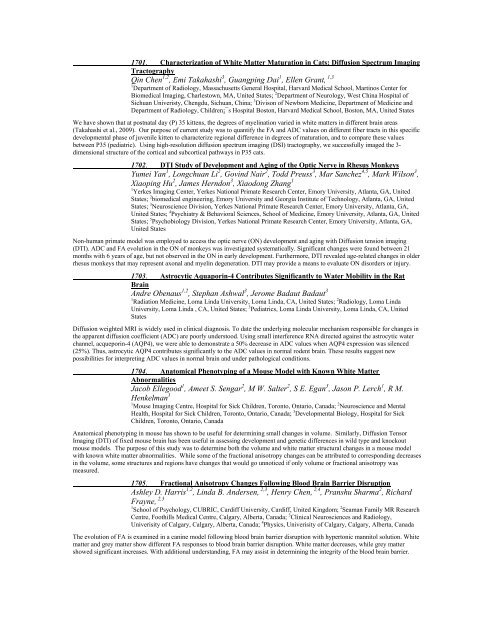Traditional Posters: Diffusion & Perfusion - ismrm
Traditional Posters: Diffusion & Perfusion - ismrm
Traditional Posters: Diffusion & Perfusion - ismrm
Create successful ePaper yourself
Turn your PDF publications into a flip-book with our unique Google optimized e-Paper software.
1701. Characterization of White Matter Maturation in Cats: <strong>Diffusion</strong> Spectrum Imaging<br />
Tractography<br />
Qin Chen 1,2 , Emi Takahashi 3 , Guangping Dai 1 , Ellen Grant, 1,3<br />
1 Department of Radiology, Massachusetts General Hospital, Harvard Medical School, Martinos Center for<br />
Biomedical Imaging, Charlestown, MA, United States; 2 Department of Neurology, West China Hospital of<br />
Sichuan Univeristy, Chengdu, Sichuan, China; 3 Divison of Newborn Medicine, Department of Medicine and<br />
Department of Radiology, Children¡¯s Hospital Boston, Harvard Medical School, Boston, MA, United States<br />
We have shown that at postnatal day (P) 35 kittens, the degrees of myelination varied in white matters in different brain areas<br />
(Takahashi et al., 2009). Our purpose of current study was to quantify the FA and ADC values on different fiber tracts in this specific<br />
developmental phase of juvenile kitten to characterize regional difference in degrees of maturation, and to compare these values<br />
between P35 (pediatric). Using high-resolution diffusion spectrum imaging (DSI) tractography, we successfully imaged the 3-<br />
dimensional structure of the cortical and subcortical pathways in P35 cats.<br />
1702. DTI Study of Development and Aging of the Optic Nerve in Rhesus Monkeys<br />
Yumei Yan 1 , Longchuan Li 2 , Govind Nair 2 , Todd Preuss 3 , Mar Sanchez 4,5 , Mark Wilson 3 ,<br />
Xiaoping Hu 2 , James Herndon 3 , Xiaodong Zhang 1<br />
1 Yerkes Imaging Center, Yerkes National Primate Research Center, Emory University, Atlanta, GA, United<br />
States; 2 biomedical engineering, Emory University and Georgia Institute of Technology, Atlanta, GA, United<br />
States; 3 Neuroscience Division, Yerkes National Primate Research Center, Emory University, Atlanta, GA,<br />
United States; 4 Psychiatry & Behavioral Sciences, School of Medicine, Emory University, Atlanta, GA, United<br />
States; 5 Psychobiology Division, Yerkes National Primate Research Center, Emory University, Atlanta, GA,<br />
United States<br />
Non-human primate model was employed to access the optic nerve (ON) development and aging with <strong>Diffusion</strong> tension imaging<br />
(DTI). ADC and FA evolution in the ON of monkeys was investigated systematically. Significant changes were found between 21<br />
months with 6 years of age, but not observed in the ON in early development. Furthermore, DTI revealed age-related changes in older<br />
rhesus monkeys that may represent axonal and myelin degeneration. DTI may provide a means to evaluate ON disorders or injury.<br />
1703. Astrocytic Aquaporin-4 Contributes Significantly to Water Mobility in the Rat<br />
Brain<br />
Andre Obenaus 1,2 , Stephan Ashwal 3 , Jerome Badaut Badaut 3<br />
1 Radiation Medicine, Loma Linda University, Loma Linda, CA, United States; 2 Radiology, Loma Linda<br />
University, Loma Linda , CA, United States; 3 Pediatrics, Loma Linda University, Loma Linda, CA, United<br />
States<br />
<strong>Diffusion</strong> weighted MRI is widely used in clinical diagnosis. To date the underlying molecular mechanism responsible for changes in<br />
the apparent diffusion coefficient (ADC) are poorly understood. Using small interference RNA directed against the astrocytic water<br />
channel, acqueporin-4 (AQP4), we were able to demonstrate a 50% decrease in ADC values when AQP4 expression was silenced<br />
(25%). Thus, astrocytic AQP4 contributes significantly to the ADC values in normal rodent brain. These results suggest new<br />
possibilities for interpreting ADC values in normal brain and under pathological conditions.<br />
1704. Anatomical Phenotyping of a Mouse Model with Known White Matter<br />
Abnormalities<br />
Jacob Ellegood 1 , Ameet S. Sengar 2 , M W. Salter 2 , S E. Egan 3 , Jason P. Lerch 1 , R M.<br />
Henkelman 1<br />
1 Mouse Imaging Centre, Hospital for Sick Children, Toronto, Ontario, Canada; 2 Neuroscience and Mental<br />
Health, Hospital for Sick Children, Toronto, Ontario, Canada; 3 Developmental Biology, Hospital for Sick<br />
Children, Toronto, Ontario, Canada<br />
Anatomical phenotyping in mouse has shown to be useful for determining small changes in volume. Similarly, <strong>Diffusion</strong> Tensor<br />
Imaging (DTI) of fixed mouse brain has been useful in assessing development and genetic differences in wild type and knockout<br />
mouse models. The purpose of this study was to determine both the volume and white matter structural changes in a mouse model<br />
with known white matter abnormalities. While some of the fractional anisotropy changes can be attributed to corresponding decreases<br />
in the volume, some structures and regions have changes that would go unnoticed if only volume or fractional anisotropy was<br />
measured.<br />
1705. Fractional Anisotropy Changes Following Blood Brain Barrier Disruption<br />
Ashley D. Harris 1,2 , Linda B. Andersen, 2,3 , Henry Chen, 2,4 , Pranshu Sharma 2 , Richard<br />
Frayne, 2,3<br />
1 School of Psychology, CUBRIC, Cardiff University, Cardiff, United Kingdom; 2 Seaman Family MR Research<br />
Centre, Foothills Medical Centre, Calgary, Alberta, Canada; 3 Clinical Neurosciences and Radiology,<br />
Univerisity of Calgary, Calgary, Alberta, Canada; 4 Physics, Univerisity of Calgary, Calgary, Alberta, Canada<br />
The evolution of FA is examined in a canine model following blood brain barrier disruption with hypertonic mannitol solution. White<br />
matter and grey matter show different FA responses to blood brain barrier disruption. White matter decreases, while grey matter<br />
showed significant increases. With additional understanding, FA may assist in determining the integrity of the blood brain barrier.















